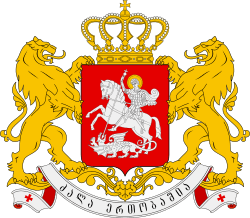Ministry of Internally Displaced Persons from the Occupied Territories, Accommodation and Refugees of Georgia
| საქართველოს ოკუპირებული ტერიტორიებიდან იძულებით გადაადგილებულ პირთა, განსახლებისა და ლტოლვილთა სამინისტრო | |
|
Coat of Arms of Georgia | |
 Logo | |
| Agency overview | |
|---|---|
| Formed | 1996 |
| Headquarters | Tamarashvili Street N 15A, Tbilisi, Georgia 0177 |
| Agency executive |
|
| Website | www.mra.gov.ge |
The Ministry of Internally Displaced Persons from the Occupied Territories, Accommodation and Refugees of Georgia (Georgian: საქართველოს ოკუპირებული ტერიტორიებიდან იძულებით გადაადგილებულ პირთა, განსახლებისა და ლტოლვილთა სამინისტრო, sakartvelos okupirebuli teritoriebidan gadaadgilebul pirta, gansakhlebisa da ltolvilta saministro), also known as Ministry of Refugees and Accommodation of Georgia is the Georgian government ministry within the Cabinet of Georgia, in charge of regulation of state policies on refugees and asylum seekers, internally displaced persons, repatriates, victims of natural disasters, their accommodation and migration control in the country.
The ministry is currently headed by Sozar Subari.[1]
Structure
The ministry is headed by the minister, aided by the First Deputy and three deputy ministers. The ministry oversees activities in development and implementation of state policy under Article 1, Paragraph 17 of the Law of Georgia on the "Structure of the Government, its Authority and the Rule of Operation". It has four functioning chapters in:
- Adjara and Samegrelo-Zemo Svaneti;
- Imereti, Guria, Racha-Lechkhumi and Kvemo Svaneti
- Kvemo Kartli, Mtskheta-Mtianeti and Kakheti
- Shida Kartli and Samtskhe-Javakheti[2]
According to Georgian authorities, Georgia has had around 251,000 IDPs from Georgian–Abkhazian and Georgian–Ossetian conflicts, the number which increased by nearly 26,000 due to 2008 Georgia-Russia conflict.[3] The ministry found itself in the media spotlight when it tried to relocate 1,500 IDPs from Tbilisi to rural areas offering $10,000 or alternative housing to each family affected by conflict.[4][5]
See also
References
- ↑ "Government of Georgia". Retrieved 2011-04-13.
- ↑ "Ministry of Internally Displaced Persons from the Occupied Territories, Accommodation and Refugees of Georgia". Retrieved 2011-04-13.
- ↑ "Ministry of Internally Displaced Persons from the Occupied Territories, Accommodation and Refugees of Georgia. IDP Issues - General Information". Retrieved 2011-04-13.
- ↑ "Georgia: UN refugee agency concerned over evictions of displaced persons". Retrieved 2011-04-13.
- ↑ Margarita Antidze (2011-01-20). "Georgia starts new wave of refugee evictions". MSNBC. Retrieved 2011-04-13.
